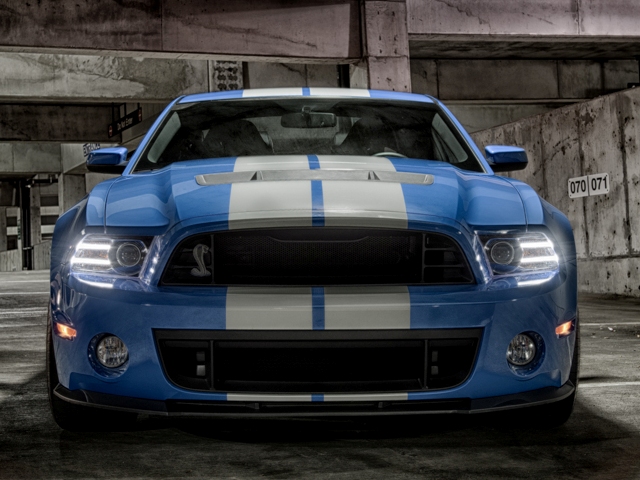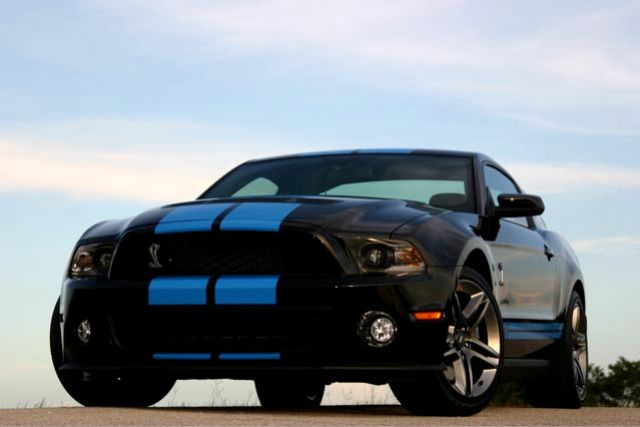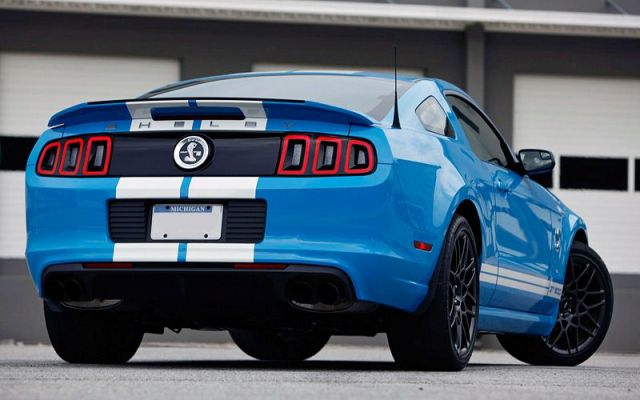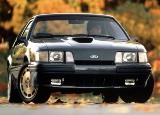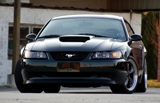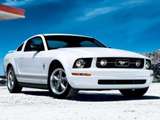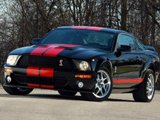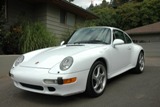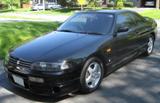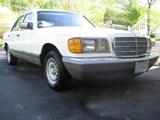Enthusiast's Corner
2010-2014 Shelby GT500: Seemingly limitless performance
Written by James Dolan
For the last few years of the S197 program Ford and SVT continually made improvements to the GT500 eventually creating a GT500 with the most powerful production V-8 engine in the world. With each iteration the Shelby Mustang just got better and better in an attempt to keep itself one step ahead of the competition. The introduction of the Camaro and Challenger signaled the end of Ford’s monopoly of the modern muscle car market but Ford wasn’t about to concede its roll of a dominate player that easily and proof of that came with the redesigned Shelby GT500.
2010 Shelby GT500
It’s fast, it’s mean and the Shelby GT500 made a roaring return for 2010 with new styling and more power under the hood. Benefitting from the styling enhancements made to the regular production Mustang, the GT500 rolled into 2010 looking sleeker and more aggressive than ever before. Ford also took the opportunity to enhance the GT500’s ride and handling dynamics as well. While not a revolutionary change the sum of all the enhancements greatly improved the GT500 for the better.
Of all the 2010 Mustang models, the Shelby GT500 probably benefitted the most from the refreshed styling. The car now possessed the hunkered down aggression that was lacking in the previous car. Up front the GT500 received its own unique front fascia with a protruding nose and large trapezoidal grille opening that allowed cool air to fill the engine bay. Just below the front bumper was a black plastic splitter designed to aid high-speed stability. Aft of the new snout the GT500 is fitted with its own specific aluminum power-dome hood with a single large functional heat extractor. At the rear, aerodynamic aids are present to keep the GT500 from getting unruly at highly illegal velocities. There was an air diffuser bolted to the lower rear bumper and a prominent rear spoiler with a Gurney Flap along its trailing edge an created by racing legend Dan Gurney in the early 1970’s. The Gurney Flap is essentially a small tab projecting from the trailing edge of the spoiler. It creates more down force than a typical rear spoiler by increasing pressure on the pressure side and decreasing pressure on the suction side.
Dressing up the exterior was a pair of GT500 lower bodyside stripes and Le Mans style twin stripes that ran from the front of the car up and over the top to the rear. These stripes were applied by hand to the car off the assembly line. If you have ever attempted installing similar stripes on your vehicle you’ll appreciate the level of skill needed to apply these stripes and the high quality level of installation on every vehicle. For 2010, buyers of convertible GT500’s could also get the Le Mans stripes that had been previously a coupe only feature. If stripes weren’t your thing you could have opted for the stripe delete option for a more subtle appearance.
The interior of the GT500 was dressed up with unique gauges with exclusive red white and blue colours for the MyColor lighting array. Charcoal Black leather trimmed seats were standard but were now adorned with twin Alcantara racing stripes that were colour coordinated with the exterior striping. Colour choices for the seat stripes included Brilliant Silver, Oxford White, Grabber Blue, Torch Red and Satin Black. If the car was ordered with stripe delete then seat striping defaulted to Satin Black. The steering wheel was trimmed with both leather and Alcantara and the shift lever and hand brake boots were also made of Alcantara giving the GT500 a more upscale feel. New 3D aluminum panels stretched out across the dash to help brighten the interior and a white cue ball shift knob with twin racing stripes sat atop the gear lever.
Inside and out, the 2010 GT500 looked and felt more special compared to the previous car. The exterior had an aggressive look that differentiated its self more from the mainstream Mustang, while the cabin benefitted from higher quality materials and snazzier detail touches. But there was more to the 2010 GT500 than just cosmetic improvements; engineers also worked hard at ratcheting up the power and handling capabilities as well.
Under the hood, engineers employed the some of the engine enhancements of the now defunct GT500KR into the 2010 GT500 along with some new ones. These upgrades included an Eaton 2300 intercooled supercharger that produced 9.0 pounds of boost; a cold air induction intake with a resonance chamber to dampen the supercharger’s deafening whine; and the addition of knock sensors to the engine that enabled more aggressive spark timing that improved both throttle response and fattened the torque curve. The results of these changes were 540-horsepower and 510-pound-feet of wheel spinning torque.
Power was transferred through a new, larger twin-disc clutch that increased durability while reducing pedal effort and cutting noise. The awesome Tremec TR6060 six-speed transmission returned; however it now had improved shift action thanks to a short shift linkage that had a direct but firm mechanical action with ultra short throws. A shorter 3.55:1 axle ratio was used to improve acceleration performance while fifth and sixth gear ratios in the transmission were lengthened to boost highway fuel economy. The increased horsepower and shorter axle ratio conspired to get the GT500 to 60 mph in around 4.5 seconds in independent tests.
Suspension engineers retuned the suspension on the GT500 coupes to improve body control and stiffen up the steering. New higher rate springs were paired with revised Tokico front struts and rear shocks that cut roll and pitch and gave the GT500 better cornering abilities. To quell understeer in the nose heavy GT500, a thinner front stabilizer bar was specified. Steering feel was improved with the installation of a firmer coupling at the steering-wheel tilt-joint that reduced steering –shaft flex. For 2010 wheels were now bumped up to 19x9.5-inches and wore special Goodyear Eagle F1 Supercar tires sized P255/40ZR19 up front and P285/40ZR19 at the rear. With the suspension improvements the GT500 was able to blast through corners with more confidence; however no amount of suspension tuning could mask the car’s nose heavy nature.
While coupes benefitted from improved suspension tuning, convertible GT500’s continued on with the softer suspension setting from the pervious car. Convertibles were also saddled with smaller 18-inch wheels and taller P255/45ZR18 tires in front and P285/45ZR18 tires at the rear. Buyers of the convertible GT500 didn’t seem to mind too much as these cars were generally purchased for their abilities as a high-speed weekend cruiser rather than an all out performance car.
New to both the coupe and convertible was Ford’s AdvanceTrac stability control system with four modes. Just as with the regular Mustangs, the system would allow for slight wheel spin and gentile drifting even when fully engaged. For more extreme driving maneuvers all the driver had to do was depress the brake pedal and push the stability control button located next to the gear lever once to turn the traction control off for a smokey burnout; twice to engage sport mode that allowed for more sliding tomfoolery before reining things in; or hold for eight seconds to completely disable the system leaving complete control to the driver.
Available options for the 2010 Shelby GT500 included HID headlamps; the outrageous Shaker 1000 audio system with a 6-disc in-dash CD changer, 10 speakers and 1000 watts of throbbing power; and the Electronics Package that included Dual-zone Electronic Automatic Temperature Control, and hard drive based, voice-activated Navigation System with 10 gigabytes of digital storage.
Even with new competition from Chevrolet and Dodge the 2010 Shelby GT500 was still king of the pony/muscle car wars but this didn’t mean that Ford was about to let the GT500 languish because 2011 brought about even more improvements for Ford’s ultimate Mustang.
2011-2012 Shelby GT500
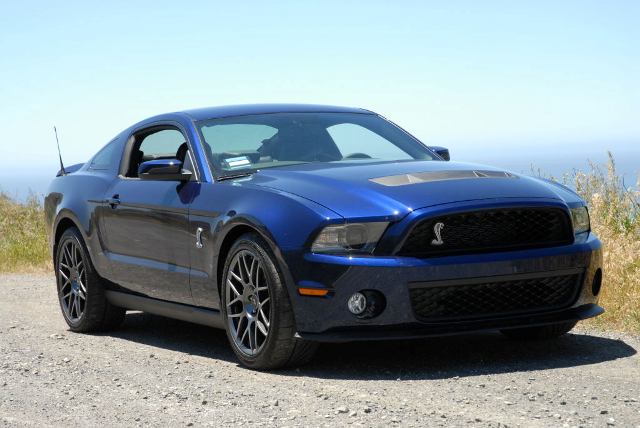
2011 Shelby GT500 equipped with the SVT Performance Package.
As amazing as the 2007-2010 Shelby GT500’s were; they did suffer from terminal understeer. No matter how hard engineers tried, they simply could not defy the laws of physics. The problem with the GT500 was that sweet 500-plus horsepower engine sitting under its hood was based on a strong, but heavy cast-iron block. This made the GT500 a minimum of 300-pounds heavier than a standard Mustang GT and almost all of that weight was directly over the front wheels. This would cause the GT500 plow into corners making its front tires howl in protest and scrub off speed when the car was pushed to its limits. When driven to eight-tenths of its abilities the GT500 was sublime but push it any further the car would quickly become les rewarding to drive. The only way to solve this problem was to put the GT500 on a diet and lop some weight off that front end. And that’s exactly what SVT did.
Out came the iron block and in its place was a new aluminum one. This aluminum block was an evolution of the one found in the Ford GT supercar minus that car’s dry sump lubrication system. The block featured six-bolt main bearing caps, larger cast-in oil drain backs, and Ford’s patented Plasma Transferred Wire Arc process to line the cylinder bores in place of the conventional steel liners. This spray-on liner coats the cylinder bores with 150-micron thick layer of composite iron and iron oxide giving the piston rings a durable surface to seat into and was predicted to be just as durable as cast-iron liners. The big advantage of this process is that it lowers weight by 8.5-pounds over steel cylinder liners and decreases friction at the same time. Inside the bock were forged-steel connecting rods and crank along with forged-aluminum pistons. Exhaust gases ran through a new, louder exhaust that boasted 38 percent less back pressure.
Another issue that engineers tackled was intake charge cooling. Ever since its introduction in 2007 the GT500 had a severe heat soak issue that didn’t affect the reliability of the car but did affect performance in a big way. On a hot day or after being driven hard and heated up the GT500 wouldn’t produce full power. This bore itself out during track testing where road testers would get wildly different acceleration times depending on the weather and how many runs down the track the car made during a particular session. On a hot day or after several passes the GT500 would simply bog down. To resolve this a larger, two-row intercooler was fitted in place of the single row unit. This new intercooler had 40 percent more cooling capacity than the previous unit. The aluminum engine block also helped as it could dissipate heat more effectively than the old iron black that tended to hold the heat in.
All the changes resulted in a more powerful engine for the GT500 that now made 550-horsepower, 10-horespower more than the 2010 car. More importantly the engine would produce all of its power more consistently no matter what the temperature was thanks to the aforementioned intercooler, better sealing and a front underbody closeout panel that directed cool air where it needed to go. Also, with the new engine engineers were successful at reducing the front end weight of the car giving the GT500 better weight distribution. Now 55.7 percent of the GT500’s weight was over the front wheels; compared to 57.4 percent for the old car. With improved weight distribution the suspension gurus could work their magic.
With the exception of electric power steering which was an improvement across the entire Mustang range there was little that changed in the GT500 with the exception that HID headlamps were now standard and the Glass Roof body style was available for the first time in the Shelby. Even the suspension retained its same state of tune from 2010. However there was the addition of the optional SVT Performance Package that finally brought the GT500’s handling inline with its colossal power.
In all honesty the SVT Performance Package should have been made standard on all 2011 GT500’s as it greatly improved the handling dynamics to the point of transforming the car into a legitimate corner carver. If you were a Mustang fan that lamented the discontinuation of the independent rear suspension when the Cobra when out of production in 2004, just as I did; get behind the wheel of a GT500 with this package and those feelings will be just about be erased.

2011 Shelby GT500 with the outstanding SVT Performance Package
The SVT Performance Package included stiffer springs with rates increased by 20.5 percent in front and 9.5 percent in the rear. New red painted shocks were installed with revised valving with increased damping. The ride height was lowered by 11 millimeters in front and 8 millimeters in the rear giving the GT500 a more aggressive stance, lower centre of gravity and increased front downforce. Unique wheels and tires were fitted with a gorgeous set of light-weight multi-spoke 19x9.5-inch painted, forged-aluminum wheels in front that wore larger P265/40R19 tires. At the rear was larger diameter 20x9.5-inch painted, forged-aluminum wheels wrapped with huge P285/35R20 rubber.
SVT worked closely with Goodyear to create the special Eagle F1 Supercar Gen-2 tires fitted to the 2011 GT500. To reduce unsprung weight the wheels were altogether 15 pounds lighter than on the standard car. A shorter 3.73:1 gear ratio with limited-slip differential was included that helped improve acceleration performance. For increased stability there was a unique rear spoiler with Gurney Flap and under-belly shield that made the car more aerodynamic.
There were also some appearance items that came with the Performance Package that included unique bodyside stripes and narrower Shelby stripes; however these could be deleted if one selected the no cost Tape Stripe Delete option. Inside, there was a special white cue ball type shift knob that deleted the twin stripes from the standard car.
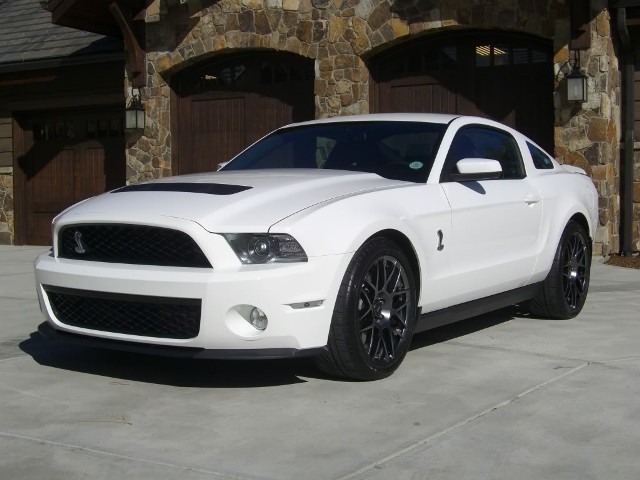
The 2012 Shelby GT500's were essentially carbon copies of the 2011 edition.
With its lighter weight aluminum engine that helped shed 100 pounds from the front of car combined with the SVT Performance Package changed the attitude of the GT500, ridding the car of its handing vices. Now the GT500 could be driven hard up to a corner and dive in under hard braking and be able to turn into the corner without the front end washing out with speed scrubbing understeer. The car was more capable, better balanced and gave the driver more confidence at the limit to the point that the GT500 was now actually fun to drive when pushed to its limits. Acceleration was also improved far beyond the slight increase in horsepower and decrease in weight would suggest. The GT500 was now able to consistently able to turn in zero-to-sixty times in the 4.1-4.3 second range, proof that the efforts made by engineers to improve intake cooling worked wonders. Sure it was still a big heavy car and an independent rear suspension would still improve the car’s dynamics further; however with the improvements to the 2011 GT500 these short comings were much less apparent to the point that the driver really didn’t care as they sprinted down a back road with a wide mouth grin plastered on their face.
Twenty-twelve editions of the Shelby GT500 were essentially carbon copies of the previous year. All three body styles returned along with options like the Electronics Package that added some luxury to the car and the transformational SVT Performance Package that brought the performance of the GT500 to the next level. Only a pair of Recaro leather covered sport bucket seats were a new addition to the options list and should be considered mandatory along with the Performance Package since the extra bolstering helped keep the driver in place whenever they explored the outer reaches of the GT500’s extreme performance. Although no changes were in store for 2012, SVT decided to throw down the gauntlet for 2013 with a maniacal 662-hosepower GT500.
2013-2014 Shelby GT500
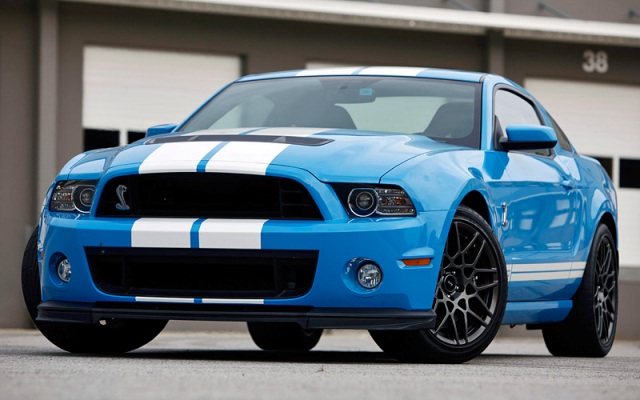
The 2013 Shelby GT500 was a 662-horsepower monster.
Six hundred and sixty two horsepower; it’s an awesome number and it’s the power rating of the brutal 2013 and 2014 Shelby GT500. That’s more power than a Corvette ZR1; in fact this was more power than any other production V-8 in the world at the time. Needing to counter Chevrolet’s 580-horsepower ZL1 Camaro, SVT engineers set a goal to produce a GT500 with a minimum of 650-horsepower, 600 pound-feet of torque and capable of reaching 200 mph. This made the new GT500 the ultimate Mustang to ever grace the streets as for as horsepower is concerned by easily eclipsing the performance numbers of its forbearers. With the death of Carroll Shelby in 2012, the 2013 GT500 made a fine tribute to the man who gave the world some of the hairiest performance cars on the planet and Ford vehicles so many victories on the track.
Aside from the astounding horsepower the rest of the 2013 GT500’s performance numbers are just as riveting. There is an axle twisting 631-pound-feet of torque. Zero to sixty miles an hour will vanish in just 3.5 seconds and the quarter mile will be obliterated in a lightning quick 11.8 seconds at 125 mph. If you are on a closed course and brave (or stupid) enough, this GT500 will reach a terminal velocity of 202 mph. And not only is it fast, it also capable of producing 1.00 g’s on a skip pad with its copious about of grip. Without a doubt the 2013 GT500 was made to not only impress but frighten anyone who came across this beast.
At the heart of the 2013 GT500 was its awe-inspiring Trinity power plant. To create the Trinity supercharged V-8, engineers used the aluminum engine from the 2011-2012 GT500 as a starting point; its self an evolution of the engine that powered the Ford GT. The cylinder bore of the aluminum block was enlarged from 90.2 millimeters to 93.5 millimeters while the 105.8 millimeter stroke remained the same. With this change engine capacity grew from 5.4-litres to 5.8-litres. Like the 2011-2012 GT500 Ford employed its patented Plasma Transferred Wire Arc process to line the cylinder bores and installed billet main-bearing caps. The compression was raised from 8.4:1 to 9.0:1 to help extract every last bit of horsepower. To cope with the stresses of the higher horsepower, the engine had a larger oil pump hidden inside the aluminum sump along with piston oil jets. The block was modified with additional coolant passages to help remove excess heat.
Bolted atop the block was a pair of aluminum cylinder heads with improved coolant flow, Ford GT cams, 37.0 millimeter intake valves and 32.0 millimeter exhaust valves. To keep the heads sealed to the block new 5-layer MLS head gaskets were used that could stand up to the increased abuse that the higher compression ratio and supercharger boost. A gorgeous pair of a valve covers painted in “Ford Blue” with a crinkle finish was bolted to the heads. Topping off the Trinity V-8 was higher capacity Twin Vortices Series 2300 supercharger that displaced a whopping 2.3-litres and could pump out a maximum boost of 14 pounds per square inch. In fact the supercharger is so large that it takes over 100-hosepower to operate. With higher boost comes more heat and to counter this engineers added cooling capacity with a huge radiator, a larger fan, a higher-flow intercooler pump, and a three row intercooler replaced the two-row unit from the previous car. All the changes cumulated into an engine that could handily out gun the previous GT500 by 112-horsepower making the Trinity most powerful production V-8 in the world.
With all its colossal horsepower and torque the rest of the GT500 needed beefing up in order to cope. There was a larger diameter dual-disc clutch that provided greater clamping force that could survive the punishment of enthusiastic drivers who wanted to experience the GT500’s earth moving 631 foot-pounds of torque without going up in smoke. The Tremec 6060 6-speed transmission was also improved with a quick action super short throw shifter and an internal oil pump. Gearing in the transmission was revised with taller ratios, with sixth gear having an ultra high 0.50 overdrive.
This use of stratospheric gearing was implemented for a few reasons. The primary reason was for fuel economy; with tall gearing the GT500’s engine is only turning 1,500 rpm in sixth gear at 80 mph. This keeps the GT500 out of gas guzzler tax territory in the United States. Another reason for the choice of ratios was for top speed; theoretically the car is geared to achieve 350 mph at 7,000 rpm in top gear, however this number is completely unrealistic thanks to the laws of physics, but the car will top out at an astounding 202 mph in the right conditions. Finally engineers decided that the tall gearing was necessary in order to keep the GT500 manageable on the street. With 662-horsepower and tall gearing the car could still be a handful, especially on wet or loose surfaces, with shorter gearing that car would be nearly impossible to drive and potentially extremely dangerous.
The two-piece steel drive shaft was tossed out in favor of an advanced one-piece carbon-fiber unit. This new carbon-fiber drive shaft was not only lighter and stronger than the old two-piece steel part; it also didn’t resonate at high speeds and cut frictional losses because the centre support bearing was eliminated. At the rear the differential received reinforced axle tubes and the axle ratio was dialed back to a less aggressive 3.31:1 gear ratio that contributed to the GT500’s remarkable fuel economy of 15 mpg in the city and 25 mpg on the highway.
To bring this rocket to a stop required Brembo 14-inch vented front rotors with larger 6-piston Brembo calipers and new brake pads. At the rear the brakes were also made larger and benefitted with a set of improved brake pads as well. The suspension was also massaged with a larger front stabilizer bar, re-valved shocks and retuned springs for the standard suspension. Once again the four mode stability control system, traction control and anti-lock brakes were all standard GT500 issue.
Another exciting feature was the addition of an rpm-adjustable electronic launch-control function accessed through the Track Apps function located on the central instrument cluster screen. To use the system, all the driver had to do was select the desired rpm and engage the system. Once the launch control was enabled, the driver depresses the clutch and fully applies the throttle. The engine will automatically settle at the predetermined speed and then the driver quickly releases the clutch and unleashes the GT500’s hellish fury upon the earth; instantly launching the car into oblivion. To keep wheel spin under control for maximum acceleration the launch control works in conjunction with the traction control system to modulate wheel spin. If the system sensed that there isn’t enough grip, during rain or on loose surfaces for example the system will automatically disengage and the traction control is fully restored to its normal function.
For those who wanted the ultimate GT500 experience there was a pair of higher performance packages. The SVT Performance Package included a Torsen limited-slip rear differential along with the standard 3.31:1 axle ratio; a firmer set of rear springs; a set of Bilstein electronically adjustable dampers; 19x9.5-inch front/20x9.5-inch rear tarnish-painted forged-aluminum multi-spoke wheels with P265/40R19 ultra performance tires on the front and P285/35R20 ultra performance tires on the rear; a unique shift knob and unique instrument cluster. There was also the SVT Track Pack that could be added when the SVT Performance Package was ordered and it included an external engine oil cooler; a transmission cooler pump; a differential cooler and brake cooler ducks to keep the massive brake from overheating during track duties.
Little changes were made to the interior and exterior of the 2013 Shelby GT500. This wasn’t necessarily a bad thing since the restyle in 2010 was so successful resulting in an aggressive and handsome shape that was arguably one of the best looking Mustangs of all time. The only real changes to the design being the large grille less opening between the headlights and huge air intake cut out of the front bumper, both changes were necessary to allow much needed air flow to cool the monstrous 5.8-litre supercharged engine. At the rear there was a very cool quad exhaust poking out beneath the rear bumper allowing keen observers to spot a 2013 GT500 as it flew past at break neck speed.
Since Ford was readying an all new Mustang for 2015 the 2014 edition of the Shelby GT500 was a carbon copy of the 2013 car and besides it would be nearly impossible to improve upon the GT500’s outrageous performance.
The 2013-2014 Shelby GT500’s were complete overkill. They were ferociously fast with brutal amounts of power that could quickly consume an inexperienced driver. In fact, even experienced driver had a hard time reining the GT500 in when the car was driven hard. To say the GT500 was a handful is an understatement as it would slither around with just the slightest prod of the throttle. It was a car that offered shameless amounts of power and speed with levels of performance that even eclipsed Ford’s own GT supercar, let alone every muscle/pony car ever produced. With its enormous power it was a dangerous car when driven without restraint or without skill. But buyers of this Mustang really didn’t care as just the thought of knowing that the car was capable of breaking the 200 mile and hour barrier and could accelerate with brute force of a rocket.
However the 2013-2014 Shelby GT500 was an example of more isn’t necessarily better. Although its sensational power could be fun it wasn’t exactly a balanced performer and as a result it wasn’t a completely rewarding car to drive. For those who appreciated pavement scorching performance in both a straight line and through the turns with razor sharp reflexes there was the exceptionally awesome 2012-2013 Boss 302.
Click here to continue reading on the next page about one of the greatest Mustangs of all time, the 2012-2013 Boss 302...
Most Popular Articles

Japanese Nostalgic Vehicles: The next trend in classic cars
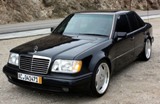
Five Sports Sedan's I'd Love to Own

Hot Hatchbacks From the 1980's

Volvo 200 Series: An Unappriciated Classic

Triumph TR-6: Music to Anyone's Ears
Fifty Years of Mustang
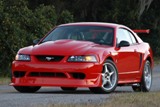
1999-2001 Ford Mustang SVT Cobra
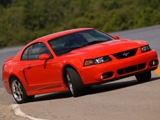
2003-2004 Ford Mustang SVT Cobra
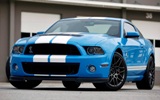
2010-2014 Ford Mustang Shelby GT500
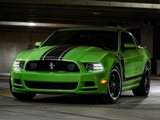
2012-2013 Ford Mustang Boss 302
Driven

Volvo 200 Series: An Unappriciated Classic

Triumph TR-6: Music to Anyone's Ears
1993 Nissan Skyline GT-s and GT-R Coupe

